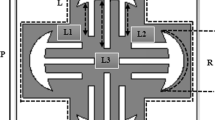Abstract
A shielded microstripline (MSL) of elliptic cross-section with finite metallization thickness penetrating into the substrate is presented. The quasi-static characteristics of this kind of MSL are studied with finit difference method (FDM). The effect of metal cross-section shape and metal penetrating depth is also studied.
Similar content being viewed by others
REFERENCES
N.N. Feng, G.R. Zhou, and D.G. Fang, Modified method of lines for open microstrip structures with finite metallization thickness and conductivity, Microwave Opt. Technol. Lett. 21 (1999), 60–63.
I.-P. Hong, S.-K. Park, H.-K. Park, Analysis on the effect of metal penetrating depth into the anisotropic substrate in a shielded microstripline, Int. J. RF and Microwave CAE 9 (1999), 49–53.
J.T. Kuo and T. Itoh, Hybrid-mode computation of propagation and attenuation characteristics of parallel coupled microstrips with finite metallization thickness, IEEE Trans. Microwave Theory Tech. 45 (1997), 274–280.
J.Y. Ke and C.H. Chen, Modified spectral-domain approach for microstrip lines with metallization thickness and conductivity, Proc. Inst. Elect. Eng. 142 (1995), 357–363.
Y.M. Tao, D.G. Fang, and X.G. Li, Full-wave hybrid-mode analysis of general structure of coplanar waveguides by using the method of lines, Microwave Opt. Technol. Lett. 7 (1994), 17–19.
G.G. Gentilli and G. Macchiarella,Quasi-static analysis of shielded planar transmission lines with finite metallization thickness by a mixed spectral-space domain method, IEEE Trans. Microwave Theory Tech. 42 (1994), 249–255.
W. Heinrich, Quasi-TEM description of MMIC coplanar lines including conductor-loss effects, IEEE Trans. Microwave Theory Tech. 41 (1994), 249–255.
R.T. Kollipara and V.K. Tripathi, Dispersion characteristics of moderately thick microstrip lines by the spetral domain method, IEEE Microwave Guided Wave Lett. 2 (1992), 100–101.
F.J. Schmuckle and R. Pregla, The method of lines for the analysis of planar waveguides with finite metallization thickness, IEEE Trans. Microwave Theory Tech. 39 (1991), 107–111.
H. Jin, M. Belanger, and Z. Jacubczyk, General analysis of electrodes in integrated-optics electrooptic devices, IEEE J. Quantum Electron 27 (1991), 243–251.
H. Jin, R. Vahldieck, M. Belanger, and Z. Jacubczyk, A mode projecting method for the quasi-static analysis of electrooptic device electrodes considering finite metallization thickness and anisotropic substrate, IEEE J. Quantum Electron 27 (1991), 2306–2314.
T. Chang and C. Tan, Analysis of a shielded microstrip line with finite metallization thickness by the boundary element method, IEEE Trans. Microwave Theory Tech. 38 (1990), 1130–1132.
C. Shih, R.B. Wu, S.K. Jeng, and C.H. Chen, Frequency dependent characteristics of open microstrip lines with finite strip thickness, IEEE Trans. Microwave Theory Tech. 37 (1989), 793–795.
M. Matsuhara, I. Toyoda, and K. Nakamura, Analysis of the waveguide with loss or gain by finite element method, Trans. IEICE Japan, J71-C (1988), 1398–1403 (in Japanese).
Z. Pantic and R. Mittra, Quasi-TEM analysis of microwave transmission lines by the finite-element method, IEEE Trans. Microwave Theory Tech. 34 (1986), 1096–1103.
S.A. Ivanov and G.L. Djankov,Determination of the characteristic impedance by a step current density approximation, IEEE Trans. Microwave Theory Tech. 32 (1984), 450–452.
A.M. Lerer and S.M. Tsvetkovskaya, Universal method of the analysis of multilayered planar lines and complex waveguides. Int. J. Microwave Millimeter-Wave CAE 7 (1997), 483–494.
B.C. Wadell,Transmission line design handbook,Artech House, Norwood, 1991.
R.K. Hoffmann, Handbook of microwave integrated circuits, Artech House, Norwood, 1989, 142.
Author information
Authors and Affiliations
Rights and permissions
About this article
Cite this article
Wang, Q., Liu, C. & Li, Y. Quasi-TEM Analysis of a Shielded Microstrip Line of Elliptic Cross-Section with Finite Metallization Thickness Penetrating into the Substrate by the Finite Difference Method. International Journal of Infrared and Millimeter Waves 21, 91–100 (2000). https://doi.org/10.1023/A:1006699022204
Issue Date:
DOI: https://doi.org/10.1023/A:1006699022204




